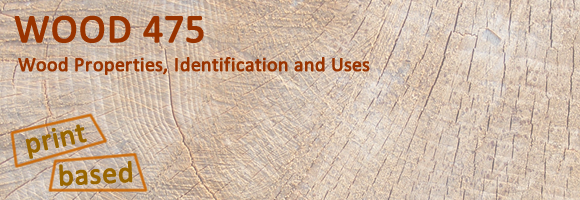
Mode of Delivery
This is a print-based, correspondence course.
Course Description
Elementary chemical, physical and mechanical properties of wood, and their variations in relation to structure; identification by hand lens features; manufacture of lumber, pulp and composite wood products.
Intended Audience
This is an overview course for forestry students who are not majoring in wood science, but who are seeking elementary knowledge of wood as a material, and its variation with the growth conditions. Manufacture of major commodity wood products is also covered, with emphasis on the relationship between wood properties and final product. Forest management students and individuals pursuing professional forestry registration through the Association of B.C. Forest Professionals should find their wood technology and forest products requirements fulfilled through successful completion of this course. It is also available to a more general audience who may be interested in the basis of the wood processing industry in B.C. and Canada.
Course Objectives
Upon successful completion of the course, you will have developed the following:
- an understanding of the influence of cell structure variation on wood properties, and the degree to which this variability can be controlled by growing conditions;
- the ability to identify 17 hardwoods and 10 softwoods in the form of individual species groups or genera, based on gross physical features and structural features visible with a 10-power hand lens;
- an understanding of the factors influencing the interaction of wood with moisture; wood weight; and the strength of wood and wood products;
- an understanding of the manufacturing processes for major forest products, and the relationships between raw material quality and final product quality; and
- an appreciation of the utilization and marketing of these forest products, and an outlook for the future for new and existing products.
Course Overview
The content divides into two parts, each with seven lessons:
Part I: Wood Anatomy and Properties
Lesson 1: Tree growth and wood formation; macroscopic character of wood; physical and chemical aspects of the wood cell wall.
Lesson 2: Wood anatomy: softwood and hardwood structure; wood identification.
Lesson 3: Moisture content, specific gravity and density.
Lesson 4: Moisture measurement, movement, and wood shrinkage; drying defects; lumber drying.
Lesson 5: Mechanical properties of wood: strength, deformation and elasticity; bending moments and stresses in wood beams; simple beam design problems; laboratory testing.
Lesson 6: Variability in strength and stiffness due to internal (wood) characteristics and external conditions; clear wood versus lumber; derivation of working stresses; mechanical stress grading.
Lesson 7: Reaction wood and juvenile wood; effect of growth conditions and silvicultural practices on wood quality.
Part II: Wood Product Manufacture, Protection and Marketing
Lesson 8: Lumber manufacture, measurement and grading; quality assurance.
Lesson 9: Composite panel products (general attributes): plywood, wafer, particle and fiber boards.
Lesson 10: Composite lumber products: edge- and end-gluing; laminating; parallel strand lumber; parallam; wood cement composites.
Lesson 11: Pulp and paper products; mechanical and chemical pulping, and their variations and combinations; effect of fiber characteristics.
Lesson 12: Biodegradation of wood; wood preservation.
Lesson 13: Wood for energy and chemical feedstocks; fuel value of wood; hydrolysis and substitution products; extractive products.
Lesson 14: Marketing of wood products.
Assignments
There are 10 graded assignments; two are wood identification quizes, three are problem sets, two are laboratory reports of wood testing processes, and the last three are written reports of visits to three different forest product mill sites.
Grading
In order to pass the course, students must:
- complete and submit all assignments before writing the final examination;
- obtain a passing mark (>50%) on the examination; and
- obtain an overall passing mark in the course.
| Assignments | 50% |
| Final Examination: | 50% |
| Total | 100% |
Learning Resources – WOOD475 Textbook Order Form
Haygreen, J.G. & Bowyer, J.L. Forest Products and Wood Science – An Introduction.
5th ed. 2007.
WOOD 475 Learner Package (includes course manual).
You will also be required to purchase a box of wood samples and have a ten-power hand lens and sharp knife for wood identification purposes.
Supplementary Materials (distributed by the Office of Learning Technology): A course videotape shows wood identification techniques as well as a number of laboratory wood-testing procedures.
